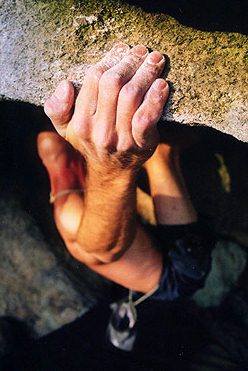Researchers Show How to Accelerate Recovery Between Climbs!
 Want to recovery faster between boulder problems and routes? If so, then "keep moving." That's the beta from several climbing researchers who have studied different recovery strategies.
Want to recovery faster between boulder problems and routes? If so, then "keep moving." That's the beta from several climbing researchers who have studied different recovery strategies. In my book Training for Climbing I explained the advantages of engaging in active recovery between climbs compared with the common practice of sitting down and resting passively. The effectiveness of active recovery for climbers was first shown in research study by Dr. Phil Watts in 2000. The authors of a brand new study, performed at the Centre for Adventure Science Research, University of Chichester, West Sussex, UK, kindly advanced me the soon-to-be-published results. Titled, Effects of Active Recovery on Lactate Concentration, Heart Rate, and RPE in Climbing, (Draper, Bird, Coleman and Hodgson 2006) this study confirms Watts' results and underscores the value of active recovery between climbs.
First let's look at Watts' study, in which 15 expert climbers attempted to redpoint a 20-meter, 5.12b gym route, with eight persons engaging in active rest (recumbent cycling) and the others assigned to passive rest immediately following completion of the route. Periodic measurements of blood lactate revealed that the active rest group returned to pre-climb blood lactic level within 20 minutes, while the passive group took 30 minutes to return to baseline levels. Therefore, low-intensity active rest accelerated the clearing of lactic acid from the blood by 50 percent.
Applying this research finding at the crag is simple. Upon completing a pumpy route or redpoint attempt, instead of sitting down and resting passively (or worse yet having a smoke), grab your water bottle and go for a light 20-minute hike. This will help clear lactic acid more quickly as well as provide a mental break from the action-both these factors will enhance your performance on the next route!
With the new study (Draper, et al. 2006), the goal was to examine the benefits of a short-duration active recovery period between repeat climbing trial (as in resting between repeated boulder problem attemps or training burns). In this randomly assigned crossover study each of ten climbers completed five two-minute climbing trails before a two-minute active or passive recovery. This was followed by a one-and-a-half minute passive refocusing period for all climbers before the subsequent climbing trial. The researchers monitored heart rate and RPE during and immediately post climbing, and fingertip capillary blood samples were collected during each refocusing phase. After the active phase climbers had higher heart rates than when following the passive recovery protocol, however, by the end of the refocusing phase the active recovery protocol led to lower heart rates than for the entirely passive recovery. There was also a significant difference between active and passive recovery conditions in lactate concentration (F(1,9) = 18.79, p = 0.002) and RPE (F(1,9) = 6.51, p = 0.031). Lactate concentration and RPE were lower across all five climbing trials for the active recovery protocol. After active recovery climbers started the next trial with a lower arterial lactate concentration than for a passive recovery and indicated lower RPE scores at the end of each climb. The refocusing period following active recovery allowed climbers heart rates to return to a lower level at the start of the next climb than for the passive recovery condition.
The upshot of this study is crystal clear: You will recover more quickly--and enhance blood lactate removal--between boulder problems and training burns by staying on your feet and moving around with moderate non-climbing activities and stretching, compared to sitting down and resting passively.
Finally, there's a third study to consider in executing your between-climb active recovery. Javier Monedero of the Human Performance Lab, Waterford Institute of Technology, Ireland compared the recovery after maximal exercise in four groups: passive rest, active rest, massage, and combined massage and active rest (Monedero 2000). After 15 minutes of rest, blood lactate removal was greatest in the group performing combined active rest and massage. Therefore, you may be able to further enhance recovery between climbs by performing some self-massage of your forearm and upper-arm muscles in addition to engaging in active recovery.
Want to learn how to recovery more quickly while you are on a climb? Check back here next month to learn about the beneficial G-Tox recovery technique!
Photo courtesy of EricMcCallister.com



 Subscribe to Eric's RSS Feed
Subscribe to Eric's RSS Feed

0 Comments:
<< Home